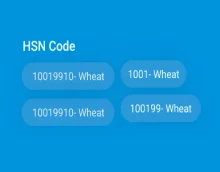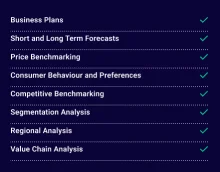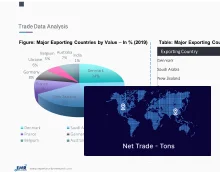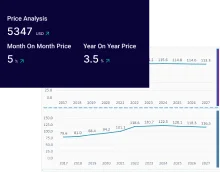
Consumer Insights
Uncover trends and behaviors shaping consumer choices today
Procurement Insights
Optimize your sourcing strategy with key market data
Industry Stats
Stay ahead with the latest trends and market analysis.
The Expert Market Research report, titled “Composite Marble Slab Manufacturing Plant Project Report 2025 Edition: Industry Trends, Capital Investment, Price Trends, Manufacturing Process, Raw Materials Requirement, Plant Setup, Operating Cost, and Revenue Statistics” includes various aspects that are critical for establishing a composite marble slab plant. These include infrastructure requirements, transportation requirements, utility specifications, and financial and economic analysis, among others.






The demand for composite marble slabs is on the rise due to several key factors. First and foremost, these slabs offer a cost-effective alternative to natural marble, making them appeal to budget-conscious homeowners and developers. For instance, in urban areas like Mumbai, where real estate prices are soaring, many builders are opting for composite marble to maintain luxurious aesthetics without inflating costs. Additionally, the increasing focus on environmental sustainability has led consumers to favour composite materials, which are often produced using recycled resources. Moreover, advancements in manufacturing technologies have significantly enhanced the quality and durability of composite marble slabs, allowing them to closely mimic the intricate veining and beauty of natural marble.
Brands like Caesarstone and Silestone have developed composite surfaces that offer a wide range of colours and patterns, catering to both residential and commercial projects. As construction activities surge globally, evidenced by rising housing permits in markets like the U.S., where approximately 358,000 housing permits were issued in early 2024 and robust growth in India’s construction sector with over 9,500 building projects documented for FY 2023-24, the demand for high-quality materials like composite marble continues to grow. This trend is particularly pronounced in luxury real estate developments, such as those seen in Dubai’s Palm Jumeirah, where builders are increasingly incorporating composite marble slabs.
Other elements to consider while establishing a composite marble slab plant include raw material sourcing, workforce planning, and packaging. The production of composite marble slabs relies on marble dust and chips, which constitute approximately 88-90% of the composition. These materials are typically sourced from the byproducts of the marble processing and mining industry, where leftover marble is crushed and repurposed for use in composite products. In addition to marble dust, high-quality resins (such as polyester or acrylic) make up about 10-12% of the mixture. Pigments are also added to achieve desired colours and patterns. Additionally, alternative materials like cullet (crushed glass) can be incorporated into the mix to create high quality composite marble slabs.
Moreover, to help stakeholders determine the economics of a composite marble slab plant, project funding, capital investments, and operating expenses are analyzed. Projections for income and expenditure, along with a detailed breakdown of fixed and variable costs, direct and indirect expenses, and profit and loss analysis, enable stakeholders to comprehend the financial health and sustainability of a business. These projections serve as a strategic tool for evaluating future profitability, assessing cash flow needs, and identifying potential financial risks.
However, challenges such as global supply chain disruptions and labour shortages may threaten supply stability in the composite marble slab industry. To combat these issues, manufacturers can diversify their supplier base and focus on local sourcing strategies. Additionally, implementing advanced inventory management systems can help mitigate supply chain risks. Companies like Stone Innovations have adopted technology-driven solutions to maintain transparency with customers about potential delays. By leveraging data analytics, manufacturers can better anticipate fluctuations in raw material availability, ensuring a steady supply of composite marble slabs.
Composite marble, also known as engineered marble, is a man-made material composed of approximately 88-90% marble dust and chips and is often combined with resins and pigments. This blend creates a durable, low-maintenance surface that closely resembles natural marble in appearance but offers enhanced strength and lower porosity. It is widely used for countertops, flooring, and various decorative applications due to its affordability and aesthetic appeal. Composite marble emerged in the late 20th century as a response to the challenges of using natural marble, such as its high cost and susceptibility to damage. Today, it stands as a popular alternative in modern architecture and design.
Composite marble slabs have a density of about 2.5 to 2.7 g/cm³, making them denser than natural marble, which has a density of around 2.6 g/cm³. These slabs have water absorption rates often below 0.1%. On the Mohs scale, their hardness ranges from 4 to 5, providing good scratch resistance while being less brittle than natural marble, which generally ranks around 3 to 5 on the same scale. Weighing approximately 25-30% less than traditional marble slabs (which can weigh up to 80 lbs per square foot), composite marble is easier to handle and install.
Chemically, composite marble consists of about 88-90% calcium carbonate combined with 10-12% resins and pigments, which significantly enhances its structural integrity. Its non-porous surface reduces moisture absorption and staining, making it suitable for high-traffic areas like kitchens and bathrooms. Additionally, composite marble exhibits greater resistance to household chemicals compared to natural marble; for instance, it can withstand pH levels from 4 to 10 without damage.
The production of composite marble slabs begins with raw material preparation, where approximately 88-90% marble dust and chips are combined with 10-12% resins and pigments. This mixture is then subjected to mixing at varying speeds, initially at 2-12 RPM, followed by 12-26 RPM, to achieve a uniform consistency. The blended material is then poured into moulds measuring 306 cm x 144 cm. Next, the mixture undergoes vibro-compaction, applying around 100 tons of pressure to eliminate air pockets and enhance density. After compaction, the slabs are cured in an oven at temperatures ranging from 80°C to 115°C for 30 to 60 minutes, allowing the resin to harden effectively. Once cured, the slabs are cut into desired dimensions, often ranging from 1.5 cm to 3 cm in thickness. The final step involves polishing the surface to achieve a smooth, glossy finish. After thorough quality inspections, the finished composite marble slabs are packaged.

Read more about this report - REQUEST FREE SAMPLE COPY IN PDF
The composite marble slab market is significantly influenced by its applications in both the residential and commercial sectors. In 2024, the U.S. residential construction sector is projected to issue approximately 358,000 housing permits in the first quarter alone, marking a 4.4% increase compared to the same period in 2023. Similarly, India’s construction industry is experiencing robust activity, with 9,501 building projects documented for FY 2023-24, covering 2.53 billion square feet. Additionally, non-residential construction spending in the U.S. is estimated at USD 1.19 trillion in March 2024, further driving the use of composite marble slabs.
Moreover, infrastructure investments driven by government initiatives are expected to further stimulate construction activities, contributing to the demand for composite marble slabs in countertops and flooring. Advancements in cutting and finishing technologies have significantly enhanced the design of composite marble slabs, which has made them more accessible for luxury infra projects. In 2024, Dubai's luxury real estate market is witnessing a surge with ultra-luxury projects such as the Como Residences, priced at AED 500 million, and the One&Only Triplex penthouse at AED 200 million. This has driven the demand for high-quality materials like composite marble.
A detailed overview of production cost analysis that evaluates the manufacturing process of composite marble slab is crucial for stakeholders considering entry into this sector. Furthermore, stakeholders can make informed decisions based on the latest economic data, technological innovations, production process, requirements of raw materials, utility and operating costs, capital investments by major players, pricing strategies, and profit margins. For instance, as of January 13, 2025, several development projects have been registered around Conroe, including a Marble Slab renovation at 10350 Hwy. 242. Other notable projects include the Shipley Do-Nuts renovation for USD 250,000, and the Golf World Clubhouse, which is a new construction project costing USD 700,000. Additionally, EOS Fitness is planning new construction with an estimated cost of USD 6.32 million. These development projects are likely to positively impact composite marble slab manufacturers. As demand for durable materials rises in both residential and commercial sectors, manufacturers can expect increased orders and sales, further stimulating growth in the composite marble market.
Below are the sections that further detail the comprehensive scope of the prefeasibility report for a composite marble slab production plant:
Market Dynamics and Trends: Rising construction activities across major economies such as China, Australia, the UK, the USA, and India are significantly impacting market conditions in the composite marble slab sector. In China, the construction industry is projected to grow by approximately 4.5% in 2024, with total output reaching around USD 1.2 trillion. This growth is largely driven by government investments in infrastructure and urban development projects aimed at stimulating economic recovery. Meanwhile, Australia anticipates a 6.9% growth rate in its construction sector, with an estimated output of AUD 193.20 billion. Despite a projected short-term decline in building construction starts, long-term trends indicate a resurgence due to significant projects like the AUUSD 330 million Eurobodalla Regional Hospital.
In the UK, construction activity is forecasted to increase by about 3%, reaching total output of EUR 170 billion in 2024, supported by rising investments in housing and infrastructure despite ongoing challenges. The USA construction market is expected to expand by approximately 5%, with expenditures projected at around USD 1.5 trillion due to federal infrastructure initiatives and a robust residential housing market. Lastly, India is set for substantial growth, with an expected increase of 7%, bringing total output to about INR 30 trillion. This growth is fuelled by government-led initiatives aimed at improving living standards. These rising construction activities create favourable conditions to produce composite marble slab sector. Understanding these demands and trends helps businesses align their production plans in the composite marble slab market.
Profiling of Key Industry Players: Leading manufacturers in the composite marble slab industry include Johnson Marble & Quartz, AGL Asian Granito, and KalingaStone. Johnson Marble & Quartz is known for its eco-friendly products and high-quality engineered stone surfaces. AGL Asian Granito offers modern designs and a variety of textures suitable for residential and commercial applications. KalingaStone offers a range of coloured marble slabs. The market for composite marble slabs is growing, driven by rising demand in construction and advancements in design technology.
Economic Analysis: Capital expenditure (CAPEX) analysis provides stakeholders the knowledge about required investments in advanced technologies, efficient machinery, and necessary infrastructure. Investing in high-capacity mixing equipment, such as a continuous mixer or high-shear mixer, can improve production efficiency by 20-30%. Investing in energy-efficient systems, such as combined heat and power (CHP) systems could reduce energy consumption by up to 30%, as these systems use waste heat from production processes to generate electricity and provide heating.
Fluctuations in prices of composite marble slabs are influenced by several key factors. Availability plays a significant role as rarer stones tend to be more expensive due to limited supply. Thickness and size also affect pricing, with larger and thicker slabs costing more due to increased material usage. Additionally, shipping costs can vary based on the distance from the quarry or manufacturing location, impacting overall expenses. Finally, market conditions, including supply and demand dynamics, economic factors, and import tariffs, contribute to price variability in the composite marble industry.
Establishing a composite marble slab manufacturing facility requires a comprehensive financial investment that encompasses various elements critical to the project's success. The following sections detail these components:
Projected profit margins and effective product pricing strategies improve overall profitability. Manufacturers might target a profit margin of around 20-30%, achieved through strategic pricing based on raw material costs and prevailing market demand. Effective pricing strategies should consider fluctuations in raw material prices and competitive positioning within the market.
This prefeasibility report aims to equip potential investors and existing manufacturers with crucial insights to make informed decisions in the composite marble slab industry.
*While we strive to always give you current and accurate information, the numbers depicted on the website are indicative and may differ from the actual numbers in the main report. At Expert Market Research, we aim to bring you the latest insights and trends in the market. Using our analyses and forecasts, stakeholders can understand the market dynamics, navigate challenges, and capitalize on opportunities to make data-driven strategic decisions.*
Get in touch with us for a customized solution tailored to your unique requirements and save upto 35%!
Basic Plan
USD 2,699
USD 2,429
Get Startedtax inclusive*
Raw Material and Product Specification, Raw material consumption, Process flow diagram
Machinery Cost, Working Capital
Utilities consumption, Operating cost, Overheads, Financing Charges, GSA , Packaging
Premium Plan
USD 3,699
USD 3,329
Get Startedtax inclusive*
Key Processing Information, Capital Investment Analysis, Conversion Cost Analysis
Raw material consumption and prices, Utilities consumption breakdown, By-Product Credit, Labour Charges Breakdown
Land and Site Cost, Equipment Cost, Auxiliary Equipment Cost, Contingency, Engineering and Consulting Charges
Enterprise Plan
USD 4,799
USD 4,079
Get Startedtax inclusive*
Key Processing Information, Capital Investment Analysis, Conversion Cost Analysis, Variable Cost Breakdown, Investing Cost Breakdown,
Breakdown of machinery cost by equipment, Auxiliary Equipment Cost, Piping, Electrical, Instrumentation
Cost of Construction, Plant Building, Site Development Charges
Land Cost, Development Charges
Dynamic Spreadsheet (Unlocked)
*Please note that the prices mentioned below are starting prices for each bundle type. Kindly contact our team for further details.*

Basic Plan
USD 2,699
USD 2,429
Key Processing Information
Raw Material and Product Specification, Raw Material Consumption, Process Flow Diagram
Capital Investment Analysis
Machinery Cost, Working Capital
Conversion Cost Analysis
Utilities Consumption, Operating Cost, Overheads, Financing Charges, GSA , Packaging

Premium Plan
USD 3,699
USD 3,329
All Contents of Basic Report
Key Processing Information, Capital Investment Analysis, Conversion Cost Analysis
Variable Cost Breakdown
Raw Material Consumption and Prices, Utilities Consumption, Breakdown By-Product Credit, Labour Charges Breakdown
Investing Cost Breakdown
Land and Site Cost, Equipment Cost, Auxiliary Equipment Cost, Contingency, Engineering and Consulting Charges

Enterprise Plan
USD 4,799
USD 4,079
Includes all Report Content
Key Processing Information, Capital Investment Analysis, Conversion Cost Analysis, Variable Cost Breakdown, Investing Cost Breakdown,
Equipment Cost Breakdown
Breakdown of Machinery Cost By Equipment, Auxiliary Equipment Cost, Piping, Electrical, Instrumentation
Land and Construction Cost Details
Land Cost, Development Charges, Cost of Construction, Plant Building, Site Development Charges
Dynamic Excel Cost Model
Dynamic Spreadsheet (Unlocked)
*Please note that the prices mentioned below are starting prices for each bundle type. Kindly contact our team for further details.*
Flash Bundle
Number of Reports: 3
20%
tax inclusive*
Small Business Bundle
Number of Reports: 5
25%
tax inclusive*
Growth Bundle
Number of Reports: 8
30%
tax inclusive*
Enterprise Bundle
Number of Reports: 10
35%
tax inclusive*
How To Order
Our step-by-step guide will help you select, purchase, and access your reports swiftly, ensuring you get the information that drives your decisions, right when you need it.

Select License Type
Choose the right license for your needs and access rights.

Click on ‘Buy Now’
Add the report to your cart with one click and proceed to register.

Select Mode of Payment
Choose a payment option for a secure checkout. You will be redirected accordingly.
Track prices with detailed trend reports.

Analyse trade data for supply chain insights.

Leverage cost reports for smart savings

Enhance supply chain with partnerships.

Gain insights to stay ahead and seize opportunities.

Get insights & trends for a competitive edge.

Track prices with detailed trend reports.

Analyse trade data for supply chain insights.

Leverage cost reports for smart savings

Enhance supply chain with partnerships.

Gain insights to stay ahead and seize opportunities.

Get insights & trends for a competitive edge.

Track prices with detailed trend reports.

Analyse trade data for supply chain insights.

Connect For More Information
Our expert team of analysts will offer full support and resolve any queries regarding the report, before and after the purchase.
Our expert team of analysts will offer full support and resolve any queries regarding the report, before and after the purchase.
We employ meticulous research methods, blending advanced analytics and expert insights to deliver accurate, actionable industry intelligence, staying ahead of competitors.
Our skilled analysts offer unparalleled competitive advantage with detailed insights on current and emerging markets, ensuring your strategic edge.
We offer an in-depth yet simplified presentation of industry insights and analysis to meet your specific requirements effectively.



Australia
63 Fiona Drive, Tamworth, NSW
+61-448-061-727
India
C130 Sector 2 Noida, Uttar Pradesh 201301
+91-723-689-1189
Philippines
40th Floor, PBCom Tower, 6795 Ayala Avenue Cor V.A Rufino St. Makati City,1226.
+63-287-899-028, +63-967-048-3306
United Kingdom
6 Gardner Place, Becketts Close, Feltham TW14 0BX, Greater London
+44-753-713-2163
United States
30 North Gould Street, Sheridan, WY 82801
+1-415-325-5166
Vietnam
193/26/4 St.no.6, Ward Binh Hung Hoa, Binh Tan District, Ho Chi Minh City
+84-865-399-124
United States (Head Office)
30 North Gould Street, Sheridan, WY 82801
+1-415-325-5166
Australia
63 Fiona Drive, Tamworth, NSW
+61-448-061-727
India
C130 Sector 2 Noida, Uttar Pradesh 201301
+91-723-689-1189
Philippines
40th Floor, PBCom Tower, 6795 Ayala Avenue Cor V.A Rufino St. Makati City, 1226.
+63-287-899-028, +63-967-048-3306
United Kingdom
6 Gardner Place, Becketts Close, Feltham TW14 0BX, Greater London
+44-753-713-2163
Vietnam
193/26/4 St.no.6, Ward Binh Hung Hoa, Binh Tan District, Ho Chi Minh City
+84-865-399-124
Share